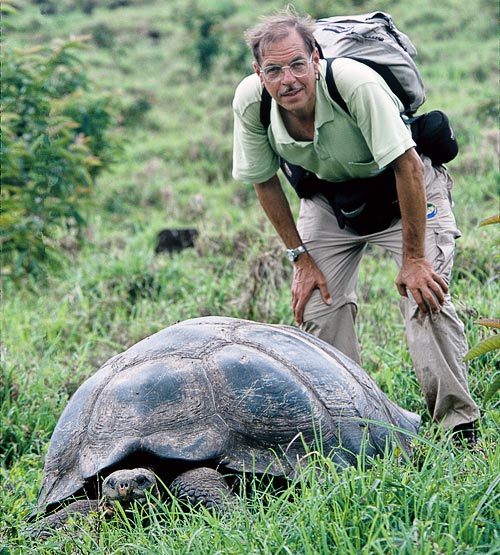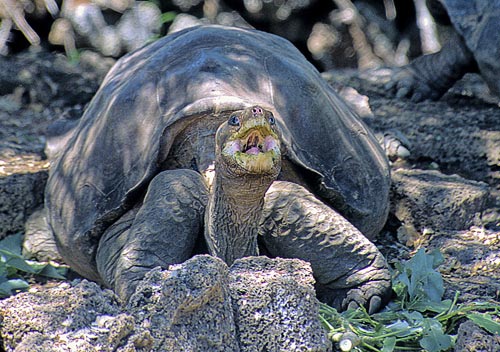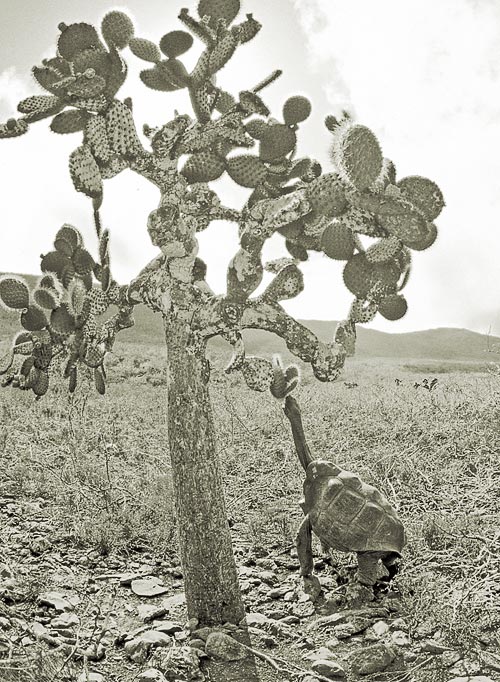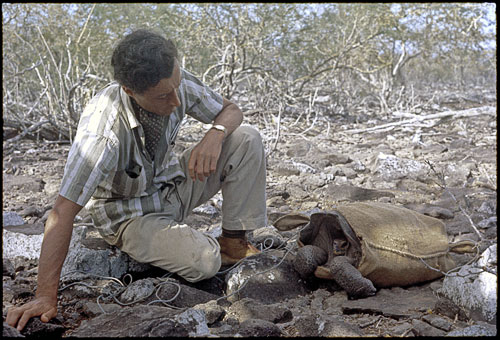
Dr. Frank J. Sulloway, standing next to a dome-shaped tortoise in the highlands of Santa Cruz Island. Photograph by Mark W. Moffett
In this week’s eSkeptic Dr. Frank J. Sulloway explores the question of whether Lonesome George — the only known giant tortoise from the island of Pinta in the Galápagos — is the last survivor of his race.
Frank J. Sulloway is a Visiting Scholar in the Institute of Personality and Social Research at the University of California, Berkeley. He has a Ph.D. in the history of science from Harvard University (1978) and is a former MacArthur Fellow. His book Freud, Biologist of the Mind: Beyond the Psychoanalytic Legend (1979) provides a radical reanalysis of the origins and validity of psychoanalysis and received the Pfizer Award of the History of Science Society. In addition, Dr. Sulloway has written about the nature of scientific creativity, and, on this topic, he has published extensively about the life and theories of Charles Darwin, including the crucial impact that Darwin’s famous Galápagos visit had on the origin of his theories. For the last two decades, Dr. Sulloway has also employed evolutionary theory to understand how family dynamics affect personality development, including that of creative geniuses. He has a particular interest in the influence that birth order and sibling competition exert on personality and behavior. In this connection, he is the author of Born to Rebel: Birth Order, Family Dynamics, and Creative Lives (1996).
Is Lonesome George Really Lonesome?
by Frank J. Sulloway
It is often asserted that Lonesome George, a Galápagos tortoise (Geochelone nigra abingdoni) from Pinta Island, is the last survivor of his race. A little known fact, however, is that a zoo in Prague houses what is claimed to be another Galápagos tortoise from Pinta. A male named Tony by his keepers, this animal is believed to have been born around 1960, based on his weight and size when he arrived at a zoo in Köln am Rhein in 1972.1
Identification of this Galápagos tortoise as coming from Pinta is based on the judgment of Peter Pritchard, one of the world’s foremost authorities on Galápagos tortoises (and of tortoises and turtles of the world more generally). In 2000, Time magazine named Pritchard as one of its “Heroes for the Planet” to honor his indefatigable efforts at turtle and tortoise conservation.2 Over the last decade, Pritchard, who founded and runs the privately funded Chelonian Research Institute in Oviedo, Florida, has amassed nearly 12,000 tortoise and turtle skeletons, as well as preserved specimens — the third largest collection in the world. He has also written an excellent monograph on Galápagos tortoises, as well as five other books on tortoises and turtles of the world. Since the early 1970s, Pritchard has engaged in extensive field work in the Galápagos Islands, including on Pinta. There, joining with park wardens from the Galápagos National Park Service, he has scoured the island in search of a surviving female (without success) and has also analyzed the bones of many dead tortoises that have been found during these searches.
Morphological criteria underlie the suspicion that the Prague’s Tony comes from Pinta. As long ago as 1835, during his own visit to the Galápagos Islands, Charles Darwin was alerted to one of the crucial inspirations for the Darwinian revolution:
I have not yet noticed by far the most remarkable feature in the natural history of this archipelago; it is, that the different islands to a considerable extent are inhabited by a different set of beings. My attention was first called to this fact by the Vice-Governor, Mr. Lawson, declaring that the tortoises differed from the different islands, and that he could with certainty tell from which island any one was brought.3
Galápagos tortoises fall into three morphological classes: dome-shaped tortoises, which live on the higher, wetter islands; saddleback tortoises, which live on the lower, drier islands; and intermediate or flat-shelled forms, which are found on a few islands presenting both habitats.4

Lonesome George relaxing in his pen at the Charles Darwin Research Station. Photograph by the author.
Like Lonesome George, Tony is a saddleback tortoise. The saddleback form derives its name from the resemblance of the shell to a Spanish saddle, turned up at the front. This distinctive carapace shape reflects an adaptation allowing tortoises to reach upward with their long necks for vegetation, and especially for the succulent pads of the Opuntia cactus, which contain substantial amounts of water. Smaller, on average, than dome-shaped tortoises, saddlebacks also have longer forelegs — two further adaptations for living in the harsher environments of the dry islands. When extending their necks fully, adult saddleback tortoises can reach a height of 1.5 meters (5.0 feet). On the low, drier islands in the Galápagos, saddleback tortoises manage to survive for years on end without any source of water other than what they are able to obtain from vegetation. This remarkable attribute contributed in significant part to the demise of the Galápagos tortoise. Having discovered that these giant creatures could survive in ship’s cargo holds for a year or more without food or water, buccaneers and whalers carted away tens of thousands as a source of fresh meat.5
As Galápagos tortoise populations declined owing to human predation, female tortoises tended to disappear more rapidly than males. Being smaller than male tortoises, females were far easier for buccaneers and whalers to carry off. In addition, females migrate annually to the lowlands where they lay their eggs. There, in the harsh volcanic terrain that inhibited exploration of the higher altitudes, female were more likely than males to be found by visitors searching for tortoise meat. The skewed sex distribution of the dwindling Pinta Island tortoise population is evident from the record of bones. During a 2003 expedition to Pinta, Pritchard and colleagues at the Galápagos National Park Service encountered the skeletal remains of fifteen tortoises in ravines and crevasses, where the animals had fallen to their deaths.6 Only one of these fifteen tortoises was a female. This 2003 discovery of the bones of a female tortoise, together with Pritchard’s earlier discovery, in 1972, of the skeletal remains of another female that bore marks of having been recently slaughtered with a machete, bolster the possibility that Pinta tortoises were still reproducing at the time Prague’s Tony was hatched. How such a young tortoise would subsequently have made its way to Europe remains a mystery, but smuggling is one possibility. Also, prior to the elaborate controls and restrictions on tourism that were established in the 1970s by the National Park Service, passing yachts could still explore the islands on their own, and such visitors sometimes did acquire tortoises as pets.

A male saddleback tortoise from Pinzón Island reaching for an Opuntia cactus pad. As a result of natural selection on islands in the Galápagos where tortoises are found, Opuntia have evolved into tree forms, reaching a height of 12 meters. On islands where tortoises have never been present, Opuntia form clumps along the ground, reaching a maximum height of only 2 meters. The close relationship between cacti and tortoises represents a classic case of coevolution. Photograph by the author.
Four different islands in the Galápagos support saddleback tortoises: Española, Pinzón, Volcán Wolf on northern Isabela, and Pinta. These four forms are morphologically distinct, at least to the trained eye.7 Scutes — the bony plates that cover the shell — differ in color and form from one saddleback population to another, as does the coloration of the face and neck. There are also differences in body size. Tortoises from Española and Pinzón are smaller than those from the other two localities. Those from Volcán Wolf are the largest and also have the highest reach with their long necks. The upward reach of tortoises from Pinta is intermediate between that of tortoises from Española and Pinzón, and those from Volcán Wolf. In addition, the highest spot on the carapace differs between various subspecies: for dome-shaped forms, the high point is at the middle of the carapace — at Vertebral 3; for saddlebacks, it is near the head, at Vertebral 1. Pinta tortoises, however, differ from other saddlebacks in having the highest point of the shell at Vertebral 2, in the shoulder region. For these and other reasons, Pritchard, who has extensively studied the bone structure of Pinta and other Galápagos tortoises, concluded that Tony was probably a Pinta tortoise. In particular, the highest part of Tony’s carapace is at Vertebral 2, as is the case with Lonesome George and the other tortoises from this island that are known from museum specimens and from bones found in the wild.8
Since the Galápagos tortoise residing at the Prague Zoo is another male, no one has sought to return it to the Galápagos, as was done, for example in the case of a male Española tortoise residing in the United States. By the late 1960s, when the surviving tortoises on this island were finally located and brought to the Charles Darwin Research Station, on Santa Cruz Island, for breeding, the Española population had shrunk to just 14 individuals (2 males and 12 females). In 1977, another male tortoise from Española, identified at the San Diego Zoo, was repatriated to the Galápagos in order to increase the genetic diversity of the breeding program. Over the last several decades, more than a thousand young Española tortoises — reared for the first few years of their lives at the Darwin Station — have been successfully returned to their native locality. Without a female tortoise from Pinta, however, an additional male from this island would be of little help in perpetuating the race via normal breeding methods. There may come a time when a second male (if this were established with certainty) would help to preserve the Pinta gene pool — for example, through crossbreeding with the closest genetic population — which, based on DNA evidence, appears to be the Española subspecies.9 For the moment, however, Tony remains at the Prague Zoo, with his status as a possible Pinta tortoise in limbo.

Roger Perry, Director of the Charles Darwin Research Station from 1964 to 1970, preparing to transport, in May 1968, one of the 14 remaining tortoises (a female) from Española to a breeding center on Santa Cruz. Photograph by Tjitte de Vries.
Identifications of tortoises from morphological features are not always certain, and the vice governor’s assertion to Darwin, in 1835, was actually something of an exaggeration—although herpetologists can generally tell most of the tortoises apart.10 A decisive test of Tony’s island identity therefore resides in an analysis of his DNA. Besides Tony in Prague, there are a substantial number of Galápagos tortoises in zoos around the world, as well as some privately owned individuals (particularly in nearby Ecuador), whose DNA has not yet been analyzed.11 Fortunately, a team of scientists headed by Michael Russello at Yale University is currently working on DNA identifications for many of these expatriate tortoises, including Tony. Still, three decades of searching, and a well-publicized reward of $10,000 for anyone who succeeds in locating a Pinta female, have so far failed to produce another tortoise from this island, and the odds would appear to be against such a hopeful find.
Whether or not Lonesome George remains the world’s only known tortoise from Pinta, one conclusion is certain. Having survived for many decades on an island where the vegetation was decimated by thousands of introduced goats, Lonesome George is well deserving of icon status in the efforts of dedicated conservationists to save the Galápagos from further ecological degradation. Readers who are moved by the plight of Lonesome George might be interested to know that they can have their own Lonesome George — or at least a very cute facsimile — and at the same time help to preserve the Galápagos and its rare species. For a donation of $100 or more to the Galapagos Conservancy (based in Falls Church, Virginia, USA), patrons receive a plush toy version of this magnificent tortoise (www.galapagos.org/membership.html). Galápagos Conservancy supports the efforts of the Charles Darwin Foundation, which runs the Charles Darwin Research Station — the home of Lonesome George since 1972.
Acknowledgments
I thank Johannah Barry, Roslyn Cameron, Jill Key, Christine Parent, Henry Nicholls, Peter Pritchard, Robert P. Reynolds, Michael Russello, Michael Shermer, Robert P. Smith, Alan Tye, Petr Velenský, Graham Watkins, and Barbara West for their assistance in connection with this essay.
References
- Velenský, Petr. 2005. “We Have Adopted a Giant Tortoise in Prague’s Zoo.” www.akcent.cz/en/p/102/helping.html
- Padgett, Tim. 2000. “Tickled about Turtles.” Time, 28 February, p. 76.
- Darwin, Charles Robert. 1845. Journal of Researches into the Natural History and Geology of the Countries Visited during the Voyage of H.M.S. Beagle round the World, under the Command of Capt. FitzRoy, R.N. 2nd ed. London: John Murray.
- Van Denburgh, John. 1914. “The Gigantic Land Tortoises of the Galapagos Archipelago.” Proceedings of the California Academy of Sciences, 4:203–374.
- Townsend, C. H. 1925. “The Galapagos Tortoises in their Relation to the Whaling Industry.” Zoologica, 4(3):55–135.
- Pritchard, Peter C. H. 2005. “The Pinta Tortoise: Globalization and the Extinction of Island Species.” Worldviews for the 21st Century, Vol. 3 (no. 2.), 46 pp. Orlando and Oviedo, Florida: University of Central Florida Global Perspectives Office and Chelonian Research Institute.
- Fritts, Thomas H. 1984. “Evolutionary Divergence of Giant Tortoises in Galapagos.” Biological Journal of the Linnean Society, 21:165–176; Pritchard, Peter C. H. 1996. The Galápagos Tortoises: Nomenclatural and Survival Status. Winter Park, Florida: Chelonian Research Foundation.
- Peter Pritchard, personal communication, 6 July 2006.
- Sulloway, Frank J. 1982. “Darwin’s Conversion: The Beagle Voyage and Its Aftermath.” Journal of the History of Biology, 15:325–396; Pritchard 1996.
- Nicholls, Henry. 2004. “One of a Kind.” Nature, 429:498–500; Nicholls, Henry. 2006. Lonesome George: The Life and Loves of a Conservation Icon. New York: Palgrave Macmillan. For a review of Nicholl‘s recent book on Lonesome George by Michael Shermer, see www.skeptic.com/eskeptic/06-06-29.html
Shermer on ABC 20/20
On July 21st, 2006, ABC 20/20 aired Psychic Hoaxes: How much would you pay to remove a ‘curse’ from your family? The show told the unfortunate story of a woman who got duped by a psychic into spending almost a quarter of a million dollars trying to remove her family curse. On the show, Michael Shermer, author of Why People Believe Weird Things, explains how people, even intelligent ones, can go from being rational to gullible, unwittingly becoming prime targets for con artists and scammers.
Audiomartini
paranormal radio with a twist
Have you ever listened to Audiomartini? The talk show, hosted by Rick Wood and sponsored by CSICOP (Committee for Scientific Investigation of Claims of the Paranormal), is the most widely syndicated skeptical radio show in the world. If you haven‘t listened to any of the shows, be sure to check them out!









